RiverRoots: Felling Penn’s Woods
RiverRoots: Felling Penn’s Woods
River Roots is Susquehanna NHA’s blog series featuring history from York and Lancaster Counties that showcases the Susquehanna River’s historic, cultural, and natural resource contributions to our nation’s heritage.
RiverRoots Heritage Blog
Long before canals or railroads, lumber rafts transported cut timber, coal, pig iron, and farm produce through Pennsylvania. The abundance of streams and rivers throughout the state brought the lumber industry to all regions of the Commonwealth. In the early 1800s, 2,500 to 3,000 arks and rafts traveled from upstate Pennsylvania from April through October. The Susquehanna River powered the lumber industry from the colonial era to the industrial revolution.
Felling Penn’s Woods
Trees covered more than 90% of Pennsylvania’s 28,692,480 acres when European settlers first laid eyes on Penn’s Woods. The white pines, oaks, and hemlocks were so tall and dense that Europeans thought that the forests were endless. The most sought-after timber was the Pennsylvania white pine. They were ideal for ships’ masts since those trees grew straight and resisted warping and wood rot. Nothing was more valuable than a blemish-free, 200-foot-tall white pine. They were so treasured that governments passed laws to protect them.
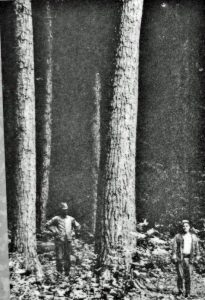
Pennsylvania provided the natural resources that fueled the country’s rapid expansion. In the 1680s, the sounds of axes and crosscut saws echoed across the forests of Pennsylvania as the colony’s first sawmills drove up the demand for lumber. Lumbermen felled trees along the Susquehanna River’s West and North Branches in the winter. The frozen ground provided a packed surface on which the logs could be more easily dragged by man or animal. Moving logs up and down mountains with primitive tools and methods was difficult and dangerous. It was not uncommon for heavy loads to skid out of control. Loggers made equipment like sleds and ox yokes onsite. The transport mode available to move the logs to market limited the amount of timber that lumbermen could harvest.
Once out of the woods, lumbermen hauled the logs to streams and rivers, where they stored the wood until the spring thaw. When the waterways flooded, the logs could float down to the sawmills. The same tributaries powered early sawmills by utilizing water wheels or elastic poles. When the water froze in winter, the sawmills couldn’t operate. Employment in the logging industry was as cyclical as the agricultural field. Winter was for felling trees, spring was for transporting logs, and summer and fall were for milling and finishing the lumber. This provided year-round employment for lumbermen.

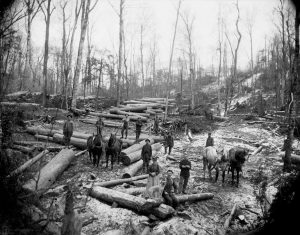
White pine logs were very buoyant and, therefore, valued for rafts and boatmaking. They could float even while carrying a heavy load. Eastern hemlocks were also popular. Hemlock bark is rich in the tannic acid used in leather tanneries, and the wood was suitable lumber. Workers carefully bound white pine logs together with pliant hickory sticks, which left no marks or damage on the valuable wood. They squared off the timber with axes and fastened them together with oak or hickory pins into floating platforms. The log platforms ranged in length from 30-80 feet.
Most of the timber cut in Pennsylvania floated down waterways via rafts made of logs lashed together, with oars attached at either end. A crew used long oars, under the guidance of an experienced pilot, to maneuver down the winding tributaries that eventually flowed into the Susquehanna River.
Types of Rafts
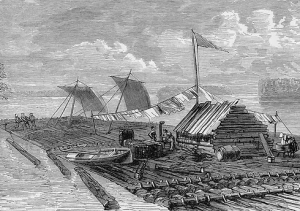
Spar Raft: Made by lashing tall, straight tree trunks together. These rafts could be 80-100 feet long, and many still had bark attached.

Timber Raft: Made of squared or timbered logs that had been partially milled into square lumber, much the shape of a railroad tie.
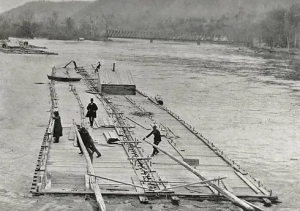
Lumber Raft: This raft consisted of logs that had already been sawed into lumber at a sawmill and could be sold as ready-to-use lumber.

River Ark: These had flat bottoms and were constructed in such a manner as to allow the transport of cargo such as pig iron, coal, farm produce, and other commodities from northern Pennsylvania.
Running the River
The lumber industry depended on Pennsylvania’s three main river systems: the Delaware River in the east, the Susquehanna through the center, and the Allegheny and Monongahela Rivers, which converge to form the Ohio River, in the west. The Susquehanna River became a highway for timber rafts. By 1796, rafts from both the north and west branch were heading downstream in droves. The west branch was often seen jammed with thousands of floating platforms in the spring. Wood arks transporting cargo downstream from New York were much more common on the north branch.
It was not uncommon for these rafts and their crews to float 300 or more miles downriver. Some rafts passed the river towns heading to Havre de Grace or Port Deposit, and from there on to southern markets. Locally, workers offloaded cargo and disassembled rafts, then sold the logs to one of the many sawmills. Marietta, Columbia, Wrightsville, and Washington Boro were popular places to off-load timber rafts, because the river was more treacherous below Turkey Hill. These river towns grew into industrial towns along the Susquehanna River.
One newspaper from the mid-1800s reported, “if a person were to stand on the banks of the Susquehanna at Washington Boro, look north to Columbia, then south to Turkey Hill, they would see a river clogged with arks and rafts anchored and ready to offload their cargo.”
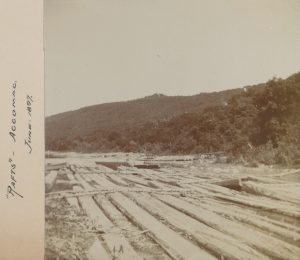 The swift and dangerous waters below Turkey Hill kept many vessels from reaching the Chesapeake Bay. Local newspapers published a few accounts describing the beauty and the dangers of rafting down the Susquehanna. Daily Evening Express published, “On a Raft” on April 29, 1867. The Intelligencer Lancaster published a story called “Journey Down the Susquehanna.” on August 18, 1875. Lancaster New Era shared on April 21, 1887, “Down the River on a Raft.” Despite the dangerous last leg of the journey, some men rode logs downriver to sell them for shipbuilding in the Chesapeake Bay.
The swift and dangerous waters below Turkey Hill kept many vessels from reaching the Chesapeake Bay. Local newspapers published a few accounts describing the beauty and the dangers of rafting down the Susquehanna. Daily Evening Express published, “On a Raft” on April 29, 1867. The Intelligencer Lancaster published a story called “Journey Down the Susquehanna.” on August 18, 1875. Lancaster New Era shared on April 21, 1887, “Down the River on a Raft.” Despite the dangerous last leg of the journey, some men rode logs downriver to sell them for shipbuilding in the Chesapeake Bay.
The men who journeyed downriver on the fresh freshets of spring knew they were in for a daring adventure. Pennsylvania raftsmen were cowboys of the river. The rafting was risky and, by nature, rivermen were reckless. Raftsmen needed an abundance of determination, brawn, and skill to deliver timber to market in the early 1800s.
It took thousands of men, braving the icy waters, to keep the millions of board feet moving downstream. The noise of raftsmen mixed with melodies from banjos, fiddles, and harmonicas and filled the air during their rough journey downriver. When they arrived in southern Pennsylvania towns, they engaged in rowdy behavior. Drinking, gambling, and fighting were commonplace, as lumber payouts meant the local taverns would be busy.
“… the rude structure shoots by… manned with a singing and saucy crew, who dodge the branches of trees, and work their steering paddles with an adroitness and nonchalance…”—Nathaniel Parker Willis, describing Susquehanna log rafting circa 1840.
At the peak of the rafting days, several hotels opened in the river towns of Marietta, Columbia, and Washington Boro. Of course, there were “parlor houses,” “bed-houses,” and “disorderly hotels” where the ladies offered companionship. Raftsman spent a night or two, then returned home. Some raftsman brought their horse for the return trip, but most returned on foot, walking hundreds of miles back upriver.
The period of 1750-1850 was the most active time of travel on the Susquehanna River. In the early 1800s, from April through October, 2,500 to 3,000 arks and rafts traveled from upstate Pennsylvania. They brought coal, lumber, pig iron, and farm produce of all varieties. The rafting industry reached its peak by 1840. The ever-expanding railroad soon put the local canals out of business.
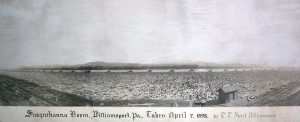
The advent of steam power in the early 1800s rapidly expanded Pennsylvania’s lumber industry. However, the Williamsport boom really powered the industry. In the fall of 1849, construction began on the massive Williamsport boom. The boom was a series of piers anchored into the riverbed that caught the floating timber. Its purpose was to bring the sawmills to the logs rather than the logs to the mills. Steam sawmills lined the riverbanks near the boom to process the hundreds of thousands of logs it held more efficiently. Williamsport became a boom town for lumber as men made their fortunes and workers flooded North and West to clear the hills.

By the 1850s, the boom’s capacity increased to 300 million board feet to keep up with Pennsylvania’s burgeoning iron furnace production. Come springtime, there were so many logs packed into the boom that you could walk on them from one side of the Susquehanna to the other. Within a short time, Williamsport became known as the “lumber capital of the world” because of its thriving lumber industry. After the Civil War broke out in 1861, the nation needed more lumber than ever. According to the Bureau of the Census, lumber production in the United States grew from 3 hundred million board feet in 1799 to 8 billion board feet in 1859, and to more than 12 billion by 1869.
The boom kept the timber industry thriving on the Susquehanna for almost 70 years. By the late 1880s, geared steam engines revolutionized the Pennsylvania timber industry by giving logging companies access to vast stands of previously inaccessible old-growth forests. It was cheaper to bring logs to Williamsport by rail than by river. Timber barons built railroads into Pennsylvania’s northern woods and used portable sawmills to cut wood on-site and haul it directly to the market. With the railroad, loggers no longer had to wait until the spring thaw.
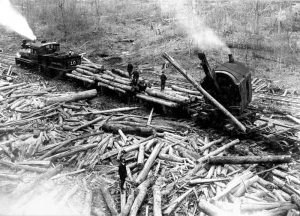
No longer dependent upon streams and rivers to float the logs to towns with mills, logging became a year-round operation. The more intensive logging accelerated the cutting of trees, leaving behind a scarred and barren landscape. Soon, little remained of the great forests of northern Pennsylvania. A flood in 1889 broke the Williamsport boom and washed masses of lumber down the river.
Rise of the Conservation Era
As Pennsylvania’s forests faded, so did the importance of the lumber industry in Williamsport. The collapse of the boom cemented its decline. When the boom broke, it set hundreds of millions of board feet of lumber loose on the Susquehanna. Temporary sawmills were set up along the riverbanks and most of the logs were recovered. In May 1908, the Susquehanna Boom Company disbanded. The following year, the boom was dismantled, ending the era of rafting on the Susquehanna River. The last commercial raft floated down the Susquehanna in 1917 and was sold to a mill in Marietta.
Each year between 1850 and 1890, about 2,500–3,000 rafts containing 150–200 million board feet of white pine traveled the West Branch of the Susquehanna. The Intelligencer published the following on June 14, 1833: “The industry quickly escalated over the next decades until the river became a super-highway of rafts. Between the 18th and 23rd of May in 1833, 2,688 arks and 3,480 rafts floated past Danville. That averages out to over 1000 rafts and arks per day or between 1 and 2 rafts every minute of the day. Their cargo was mostly grain and lumber.”
By the 1870s, Pennsylvania’s forests were disappearing. In 1885, Nebraska created Arbor Day as a day to plant trees to celebrate and safeguard forests. Other states followed, and the federal government recognized the need to protect and replenish the country’s wooded regions by the 1890s. It created the Division of Forestry, which established forest reserves around the country. The father of Pennsylvania forestry, Joseph T. Rothrock, became the state’s first forestry commissioner in 1895. Leaders in conservation like Governor Gifford Pinchot, Mira Dock, and J. Horace McFarland worked diligently to educate the public about forests.
By the 1920s, only twenty-five thousand acres of original forest remained. Since a majority of the old-growth forests in Pennsylvania were gone, the Commonwealth purchased thousands of acres of land from lumber companies and began to regulate and reforest the landscape. This gave birth to the modern conservation movement that continues to influence modern-day forestation practices. The Pennsylvania lumber industry continues to exist, but it utilizes new and improved technologies aim to balance the need for wood products with ecological needs.
Learn More
In commemoration of historic log rafting on the Susquehanna River, a group of individuals built a raft and floated down the River. On March 14, 1938, the “Last Raft” set off from Clearfield County for a historical re-enactment down the Susquehanna River. Throngs of people lined the riverbanks along the 200-mile route downriver. As the 112-foot raft passed under a railroad bridge in Muncy, it struck a pier and sank. Seven passengers drowned in the frigid water. Despite the tragedy, the raft journeyed on to Harrisburg, where it was sawed into timber and sold. Learn more about the story of the “Last Raft”.
Learn more about Pennsylvania’s Lumber Industry.
Sources
Brubaker, J. H. (2002). Down the Susquehanna to the Chesapeake. Pennsylvania State University Press.
Lauver, F. (2017, July 11). The Pennsylvania Lumber Museum preserves an industrial history. Pennsylvania Heritage Magazine.
Magee, D. F. (1920). Rafting on the Susquehanna. Lancaster County Historical Society.
Stranahan, S. Q. (1995). Susquehanna, River of Dreams. Johns Hopkins Univ. Press.
Susquehanna Log Boom. Pennsylvania Conservation Heritage. (2020, December 17).
Susquehanna. Blue Rock Heritage.
Wagner, V., Shellenberger, K., & Poticher, C. The story of the Montour log raft.
